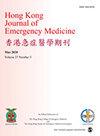气溶胶外壳屏障对视频喉镜下经口气管插管的影响:一项飞行员人体模型研究
IF 0.8
4区 医学
Q4 EMERGENCY MEDICINE
引用次数: 3
摘要
背景:目前——2020年,用于保护医护人员抗击严重急性呼吸系统综合征冠状病毒2型大流行的个人防护设备在全球范围内供应有限。在气管插管期间使用隔离罩可能是一种具有成本效益的辅助手段,可以最大限度地降低将感染传染给医护人员的风险。然而,有人担心,在紧急情况下,外壳本身会成为插管程序的障碍。目的:评估屏障外壳(气溶胶盒)对人体模型中视频辅助插管性能的负面影响。方法:共招募了来自当地医院的41名急诊科医生,在模拟正常和更困难的气道(Cormack Lehane I级和IIb级)的人体模型中进行插管。主要结果是插管成功的时间。次要结果是参与者认为的首次尝试成功率、成功尝试次数、辅助治疗的需要、牙齿损伤和插管的容易程度。结果:雾化盒对气管插管成功时间无明显影响(p = 0.630(I级气道)和p = 0.436(IIb级气道))、首次尝试成功率、成功尝试次数、是否需要辅助治疗或牙齿损伤。参与者主观地报告了在有盒子的情况下插管过程中出现的额外但轻微的挑战。结论:在试点研究的范围内,气雾盒没有统计学上的显著差异,但在IIb级气道中,气管插管间隔延长的趋势不断增加,并对首次通过的成功率产生负面影响,可用于在产生气雾的插管过程中保护医护人员。本文章由计算机程序翻译,如有差异,请以英文原文为准。
Impact of aerosol enclosure barrier to videolaryngoscopic oro-tracheal intubation: A pilot manikin study
Background: Personal protective equipment used for protection of healthcare workers in the combat against Severe Acute Respiratory Syndrome Coronavirus 2 pandemic is in limited supply worldwide at present – 2020. Use of barrier enclosure during endotracheal intubation can potentially act as a cost-effective adjunct to minimize risks of transmitting the infection to healthcare workers. However, there is concern that the enclosure itself will act as a barrier to the intubation procedure in the emergency settings. Objective: To evaluate the negative effect of barrier enclosure (an aerosol box) on the performance of video-assisted intubation in a manikin Methods: A total of 41 Emergency Department doctors from a local hospital were recruited to perform intubation in a manikin simulating normal and more difficult airways (Cormack-Lehane grades I and IIb) with and without the box. The primary outcome was time of successful intubation. The secondary outcomes were first-attempt success rate, number of successful attempts, need of adjuncts, dental injury and ease of intubation as perceived by the participants. Results: The aerosol box had no significant negative effect on the time of successful intubation (p = 0.630 (Grade I airway) and p = 0.436 (Grade IIb airway)), first-attempt success rate, number of successful attempts, need of adjuncts or dental injury. Participants subjectively reported extra yet minor challenges during intubation in the presence of the box. Conclusion: Within limits of the pilot study, the aerosol box had no statistical significant difference but an increasing trend of prolonged endotracheal intubation interval in the Grade IIb airway and negative impact on first-pass success, and could potentially be used to protect healthcare workers during the aerosol-generating intubation procedure.
求助全文
通过发布文献求助,成功后即可免费获取论文全文。
去求助
来源期刊

Hong Kong Journal of Emergency Medicine
EMERGENCY MEDICINE-
CiteScore
1.50
自引率
16.70%
发文量
26
审稿时长
6-12 weeks
期刊介绍:
The Hong Kong Journal of Emergency Medicine is a peer-reviewed, open access journal which focusses on all aspects of clinical practice and emergency medicine research in the hospital and pre-hospital setting.
 求助内容:
求助内容: 应助结果提醒方式:
应助结果提醒方式:


